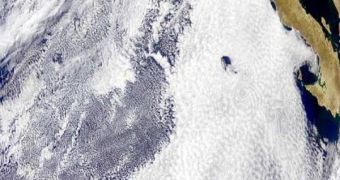In the decades since global warming started being acknowledged as a harsh reality, researchers and climatologists have often wondered how the clouds will influence the global rise in temperatures. Increasingly large amounts of greenhouse gases (GHG) can have two effects in the atmospheric formations – they can either cause dissipation, which would allow for more sunlight and radiation in, or accumulation, which would block solar influence, and slow down the progression of climate change. A new study, seeking to assess these possibilities, appears in the July 24th issue of the journal Science.
A team of American researchers, led by University of Miami Rosenstiel School of Marine and Atmospheric Science experts Amy Clement and Robert Burgman, and University of California in San Diego (UCSD) Scripps Institution of Oceanography scientist Joel Norris, has taken it upon itself to conduct this investigation. The scientists used large amounts of available data, collected over the past 50 years, as well as complex computer simulations, in order to determine future cloud behavior patterns.
They found out that low-level stratiform clouds appeared to be heavily influenced by the warming of the ocean, and that higher temperatures seemed to cause dissipation, instead of accumulation. This unfortunately means that the warmer the planet gets, the less low-altitude clouds will be formed, and the more sunlight will come through the atmosphere. This will most likely create a vicious circle, in which increased temperatures allow for larger amounts of solar radiations coming in, which, in turn, cause even higher temperatures.
“The agreement we found between the surface-based observations and the satellite data was almost shocking. These are subtle changes that take place over decades. It is extremely encouraging that a satellite passing miles above the earth would document the same thing as sailors looking up at a cloudy sky from the deck of a ship,” Amy Clement says. She is a University of Miami professor of meteorology and physical oceanography, and also the winner of the American Geophysical Union's 2007 Macelwane Award. She got the award for outstanding work in understanding climate change.
“This is somewhat of a vicious cycle potentially exacerbating global warming. But these findings provide a new way of looking at clouds' changes. This can help to improve the simulation of clouds in climate models, which will lead to more accurate projections of future climate changes,” she adds. “I am optimistic that there will be major progress in understanding global cloud changes during the next several years. The representation of clouds in models is improving, and observational records are being reprocessed to remove spurious variability associated with satellite changes and other problems,” Norris concludes.

 14 DAY TRIAL //
14 DAY TRIAL //